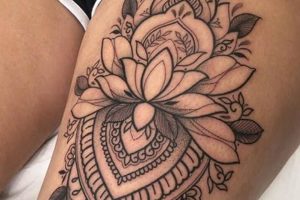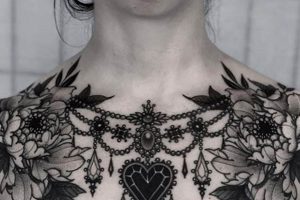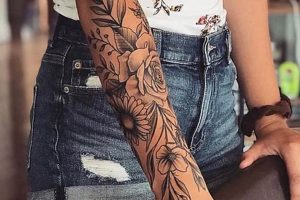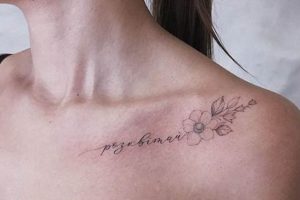Concealing unwanted ink involves transforming existing tattoos into new artwork. This process often requires artistic skill and careful planning to effectively integrate the old design into the new. For example, a dark, tribal armband might be incorporated into the foliage of a nature scene, or a small, faded name could become the center of a blossoming flower.
Renewing body art offers significant emotional and aesthetic benefits. It allows individuals to reclaim their bodies by replacing designs that no longer resonate with their personal style or values. This can boost self-confidence and provide a sense of closure. Over time, tattooing techniques and trends have evolved, making older tattoos appear dated or less refined. A cover-up offers the opportunity to modernize and enhance the aesthetic quality of existing body art.
Factors influencing successful transformations include the size, color, and location of the original tattoo, as well as the skill and experience of the artist. Exploring diverse artistic styles, such as realism, watercolor, or geometric designs, opens up a range of possibilities. Consulting with a skilled tattoo artist is crucial to discuss options and develop a personalized approach that achieves the desired aesthetic outcome.
Tips for Concealing Unwanted Tattoos
Careful consideration of several factors contributes to successful tattoo transformations. The following tips offer guidance for individuals seeking to conceal existing ink.
Tip 1: Consult with Experienced Artists: Research and select artists specializing in cover-ups. Review portfolios to assess their skill in seamlessly integrating existing designs into new artwork.
Tip 2: Assess Existing Ink: Factors like size, color saturation, and location influence cover-up options. Darker, larger tattoos require more intricate designs and potentially multiple sessions.
Tip 3: Explore Artistic Styles: Research various tattoo styles (realism, watercolor, geometric, etc.) to determine which best suits personal preferences and effectively conceals the existing tattoo.
Tip 4: Consider Color Theory: Understanding color theory aids in selecting appropriate pigments to neutralize or incorporate existing ink. Darker colors are generally more effective for coverage.
Tip 5: Manage Expectations: Complete coverage may not always be possible. Be open to incorporating elements of the old tattoo into the new design for a more seamless transition.
Tip 6: Prioritize Aftercare: Proper aftercare is essential for both the new tattoo and the successful concealment of the old one. Follow artist instructions diligently to minimize scarring and ensure optimal healing.
Tip 7: Plan for Multiple Sessions: Larger or more complex cover-ups often require multiple sessions to achieve the desired result. Be prepared for a longer process and associated costs.
By considering these factors and working closely with a skilled artist, individuals can transform unwanted tattoos into meaningful and aesthetically pleasing artwork. This process allows for renewed self-expression and a positive shift in personal body image.
Ultimately, the journey of transforming a tattoo is a collaborative effort between the individual and the artist. Open communication and realistic expectations are crucial for achieving a successful outcome.
1. Artist Specialization in Cover-Ups
Artist specialization in cover-ups plays a critical role in the successful transformation of unwanted tattoos, particularly for women who often prioritize aesthetics and subtle integration of new artwork. Cover-up artistry demands a distinct skill set beyond general tattooing. It requires a deep understanding of color theory to effectively neutralize existing ink, as well as expertise in design adaptation to seamlessly incorporate or obscure previous artwork. An experienced cover-up artist possesses the technical proficiency to work with varying skin tones and textures, recognizing how these factors impact pigment saturation and overall design visibility. This specialized knowledge is essential for creating visually appealing results that address the specific needs and preferences of each individual.
Consider a scenario where a woman seeks to cover a faded, dark tribal tattoo on her shoulder with a delicate floral design. A general tattoo artist might simply attempt to overlay the new design, potentially resulting in the old ink showing through or clashing aesthetically. A specialized cover-up artist, however, would strategically select colors and design elements to neutralize the existing tribal pattern and seamlessly integrate it into the new floral artwork. This might involve using darker shades to create depth and shadows within the floral design, effectively obscuring the unwanted tribal elements while enhancing the overall aesthetic. This specialized approach requires a nuanced understanding of color interaction and design principles specific to cover-up artistry.
Successful cover-up tattoos often involve multiple sessions and require significant artistic planning. Choosing an artist with a proven track record in cover-ups is essential. Portfolios showcasing successful transformations, testimonials from satisfied clients, and a demonstrable understanding of the complexities involved are crucial indicators of expertise. This specialized skill set ensures not only aesthetic improvement but also addresses the emotional significance associated with replacing unwanted body art. The resulting transformation offers individuals renewed confidence and a positive shift in their relationship with their body image.
2. Size and color of existing tattoo
The size and color of an existing tattoo significantly impact cover-up options for women. Larger tattoos present a greater challenge, requiring more intricate designs and potentially multiple sessions. Darker, more saturated colors necessitate careful color selection in the cover-up design, often relying on darker pigments for effective concealment. Smaller, lighter tattoos offer more flexibility, allowing for a wider range of design choices and potentially simpler execution. For example, a small, faded name tattooed in a light color might be easily concealed with a floral design, while a large, dark tribal tattoo would necessitate a more complex and strategically planned cover-up, potentially incorporating elements of the original design.
Color theory plays a crucial role in successful cover-ups. Darker inks, such as black and deep blues or greens, are more effective at covering existing dark ink. Lighter colors, while aesthetically pleasing, may not provide sufficient coverage and could result in the old tattoo showing through. An experienced tattoo artist skilled in color theory can strategically use contrasting and complementary colors to neutralize existing ink and create a visually appealing new design. For instance, orange can be used to counteract blue hues, while green can help neutralize red tones. Understanding these color relationships is fundamental for achieving a successful cover-up.
Effective cover-ups require a thorough assessment of the existing tattoo’s size and color, coupled with a deep understanding of color theory and design principles. This assessment informs design choices, color selection, and the overall strategy for concealing the unwanted artwork. Consultation with a skilled tattoo artist specializing in cover-ups is crucial for determining the best approach and ensuring a successful transformation. Realistic expectations are essential, as complete coverage may not always be feasible, particularly with larger or darker tattoos. In some cases, incorporating elements of the original design into the new artwork might be the most effective strategy for achieving a harmonious and aesthetically pleasing result.
3. Skin Tone and Location
Skin tone and tattoo location are critical factors influencing cover-up design and execution for women. These elements directly impact ink visibility, color vibrancy, and the overall aesthetic of the final result. Understanding the interplay between skin tone, location, and cover-up artistry is crucial for achieving a successful and aesthetically pleasing transformation.
- Melanin and Pigment Interaction
Varying melanin levels in different skin tones affect how tattoo pigments appear. Darker skin tones require bolder, more saturated colors for optimal visibility, while lighter skin tones may be more susceptible to ink migration and require careful pigment selection to prevent unwanted blurring or discoloration. Certain colors, particularly lighter shades, may not be suitable for darker skin tones, necessitating alternative design choices. An artist experienced in working with diverse skin tones possesses the knowledge to select appropriate pigments and adjust design elements accordingly.
- Location and Design Adaptation
The location of the existing tattoo influences design choices for the cover-up. Areas with more movement, such as joints or muscles, may require designs that accommodate flexibility and skin stretching. Body contours and natural shadows can be incorporated into the cover-up design to create a more seamless and natural-looking result. For example, a cover-up on the rib cage might benefit from a design that flows with the natural curves of the body, while a cover-up on a flatter area like the back offers more flexibility in design choices.
- Scarring and Skin Texture
Existing scar tissue from the original tattoo can influence the cover-up process. Scarred skin may not accept ink as readily as unscarred skin, potentially impacting color saturation and overall design clarity. An experienced artist can assess the skin’s condition and adjust techniques accordingly, potentially requiring multiple sessions or alternative design elements to accommodate the presence of scar tissue.
- Sun Exposure and Pigment Fading
Areas frequently exposed to sunlight, such as arms and legs, are more susceptible to pigment fading over time. This factor influences color selection for cover-ups, as lighter colors may fade more quickly in these areas. Choosing darker, more saturated pigments can help ensure longevity and prevent the original tattoo from becoming visible through the cover-up as it ages.
By carefully considering the interplay between skin tone, tattoo location, and the desired cover-up design, women can achieve successful and aesthetically pleasing results. Consulting with a skilled tattoo artist experienced in cover-up artistry is crucial for navigating these complexities and developing a personalized approach that addresses individual needs and preferences.
4. Desired Style and Imagery
Aligning desired style and imagery with existing tattoo characteristics is crucial for successful cover-ups, particularly for women seeking aesthetically pleasing and personally meaningful transformations. The selected style influences not only the visual outcome but also the technical feasibility of concealing the previous artwork. Careful consideration of stylistic elements, such as color palettes, linework, and overall composition, ensures a harmonious integration of the new design with the individual’s aesthetic preferences and the constraints posed by the existing tattoo.
- Realism and Detail
Realistic designs, often incorporating intricate details and shading, can effectively camouflage unwanted tattoos by creating visual depth and distraction. For example, a portrait or a nature scene can strategically incorporate the existing tattoo’s lines and colors into the new composition, effectively concealing it within the realistic imagery. However, realism requires a highly skilled artist and may involve multiple sessions, particularly for larger or darker existing tattoos.
- Watercolor and Abstraction
The fluidity and vibrant colors of watercolor tattoos can be particularly effective for concealing existing artwork by creating a visually dynamic and less defined composition. Abstract designs offer similar advantages, allowing for greater flexibility in incorporating the existing tattoo’s shapes and colors into the new artwork. These styles can be particularly appealing for covering tattoos with less defined lines or faded colors.
- Geometric and Tribal Influences
Geometric patterns and tribal designs offer strong visual elements that can effectively mask unwanted tattoos. Bold lines and intricate patterns create a sense of structure and can strategically incorporate or obscure existing ink. These styles are often well-suited for covering older tribal tattoos or designs with strong geometric elements.
- Floral and Botanical Motifs
Floral and botanical imagery provides versatile cover-up options, allowing for creative incorporation of existing tattoo elements into the natural flow and organic shapes of flowers, leaves, and vines. These designs offer a softer, more feminine aesthetic and can be adapted to various sizes and locations, effectively concealing unwanted ink while adding a touch of elegance and natural beauty.
Ultimately, the chosen style and imagery should reflect the individual’s personal aesthetic and complement the existing tattoo’s characteristics. Collaborating with a skilled artist specializing in cover-ups is essential for navigating these considerations and developing a design that seamlessly integrates artistic vision with technical feasibility, resulting in a transformative and empowering experience.
5. Pain Tolerance and Budget
Pain tolerance and budget are practical considerations significantly influencing cover-up tattoo decisions for women. These factors directly impact design complexity, session duration, artist selection, and ultimately, the overall success and satisfaction with the final result. Understanding the interplay between pain management, financial constraints, and artistic vision is crucial for making informed choices and achieving realistic expectations.
- Session Length and Complexity
Intricate cover-up designs often require multiple sessions, particularly when addressing larger or darker existing tattoos. Each session involves a degree of discomfort, and individual pain tolerance dictates the length and frequency of these sessions. Longer sessions allow for more progress but can be taxing, while shorter, more frequent sessions might be more manageable but extend the overall process. Budget constraints can also influence session length, as longer sessions typically incur higher costs.
- Artist Selection and Expertise
Experienced and specialized cover-up artists often command higher rates due to their expertise and demand. Budget limitations may restrict access to top-tier artists, potentially impacting the quality and effectiveness of the cover-up. While less experienced artists may offer lower rates, their skill level in color theory, design adaptation, and scar tissue management might be less developed, potentially compromising the final result. Balancing artistic skill and affordability is a crucial aspect of the decision-making process.
- Pain Management Strategies
Various pain management techniques, such as topical numbing creams, breathing exercises, and over-the-counter pain relievers, can influence session length and overall comfort. Individual responses to these methods vary, and some may involve additional costs. Discussing pain management strategies with the chosen artist during the consultation phase allows for personalized planning and preparation, contributing to a more positive and manageable experience.
- Long-Term Costs and Aftercare
Cover-up tattoos often require touch-up sessions to ensure optimal color saturation and design longevity, particularly in areas prone to fading or skin changes. These additional sessions represent a long-term financial commitment that should be factored into the initial budget. Proper aftercare, including specialized creams and ointments, also contributes to successful healing and pigment retention but adds to the overall cost. Investing in high-quality aftercare products and diligently following artist instructions minimizes complications and maximizes the long-term aesthetic value of the cover-up.
By carefully considering pain tolerance, budget constraints, and available pain management strategies, women can make informed decisions about cover-up design, artist selection, and session planning. Open communication with the chosen artist about financial limitations and pain management preferences fosters a collaborative approach, ensuring a positive, manageable, and ultimately successful tattoo transformation experience. Balancing artistic aspirations with practical considerations is key to achieving a result that is both aesthetically pleasing and financially responsible.
6. Aftercare Commitment
Successful tattoo cover-ups require a significant aftercare commitment, especially for women who often prioritize aesthetics and seamless integration of the new artwork. Diligent aftercare is essential not only for the health of the new tattoo but also for the effective concealment of the previous design. Neglecting proper aftercare can compromise the vibrancy of the new ink, potentially allowing the old tattoo to show through, and may lead to complications like infection or scarring, further hindering the cover-up’s success.
- Infection Prevention
A fresh tattoo, especially a cover-up worked over existing ink, represents a wound susceptible to infection. Diligent cleaning and application of antibacterial ointments, as instructed by the artist, minimizes infection risk. Infections can cause discoloration, scarring, and ink loss, severely compromising the cover-up’s effectiveness and potentially necessitating further corrective work.
- Color Vibrancy and Longevity
Proper aftercare, including moisturizing and avoiding sun exposure, preserves the vibrancy and longevity of the new tattoo ink. This is crucial for cover-ups, as faded ink can allow the old tattoo to reappear. Consistent moisturizing keeps the skin healthy and promotes optimal ink retention, ensuring the cover-up remains effective over time.
- Scar Tissue Minimization
Cover-ups often involve working over existing scar tissue from the previous tattoo. Proper aftercare minimizes further scarring and promotes healthy skin regeneration, crucial for a smooth and even surface for the new ink. Excessive scarring can distort the new design and compromise its ability to effectively conceal the old tattoo.
- Ink Retention and Settling
Following aftercare instructions precisely, including avoiding picking or scratching the tattooed area, allows the ink to settle properly into the skin. This is particularly important for cover-ups, as disturbing the healing process can dislodge ink particles, affecting color saturation and potentially revealing the old tattoo underneath.
Commitment to diligent aftercare is therefore integral to successful tattoo cover-ups for women. It directly impacts the longevity, vibrancy, and overall effectiveness of the new design in concealing the previous artwork. By prioritizing aftercare, individuals maximize the aesthetic outcome and ensure the long-term success of their tattoo transformation, fostering confidence and a positive relationship with their body art.
7. Consultation and Planning
Thorough consultation and planning form the cornerstone of successful tattoo cover-ups for women. This crucial preliminary stage establishes a collaborative relationship between the individual and the artist, ensuring alignment of expectations, artistic vision, and technical feasibility. Effective consultation clarifies the complexities involved in concealing existing ink, addresses individual concerns, and sets the stage for a positive and transformative experience.
- Assessing Existing Tattoo Characteristics
Initial consultation involves a detailed assessment of the existing tattoo’s size, color, location, and skin condition. This assessment informs design possibilities, color selection, and the overall cover-up strategy. For example, a large, dark tattoo requires a different approach than a small, faded one. Understanding these characteristics is fundamental for developing a realistic and achievable plan.
- Exploring Design Options and Artistic Styles
Consultation provides an opportunity to explore various design options and artistic styles, aligning personal preferences with technical feasibility. Individuals can discuss desired imagery, color palettes, and overall aesthetic goals with the artist, who can then offer expert guidance on how to effectively incorporate or obscure the existing tattoo. This collaborative process ensures the new design resonates with the individual’s style while effectively addressing the cover-up’s technical challenges.
- Addressing Pain Tolerance and Budgetary Constraints
Open communication about pain tolerance and budgetary limitations is essential during consultation. Discussing these factors allows the artist to tailor the design and session plan to individual needs and financial constraints. This transparency ensures a manageable and positive experience while respecting individual comfort levels and financial boundaries.
- Establishing Aftercare Expectations and Responsibilities
Consultation provides a platform for establishing clear aftercare expectations. The artist can explain proper aftercare procedures, emphasizing their importance in achieving optimal healing, color vibrancy, and long-term cover-up success. This proactive approach minimizes potential complications and ensures the individual understands their role in maintaining the integrity of the new tattoo.
Effective consultation and planning are therefore integral to achieving successful and satisfying tattoo cover-up outcomes for women. This collaborative process establishes a foundation of understanding, manages expectations, and ensures alignment between artistic vision, technical feasibility, and individual needs. By prioritizing this crucial preliminary stage, individuals embark on the cover-up journey with confidence and a clear understanding of the process, maximizing the potential for a transformative and empowering experience.
Frequently Asked Questions about Tattoo Cover-Ups
Addressing common concerns and misconceptions surrounding tattoo cover-ups empowers individuals to make informed decisions and embark on the transformation process with confidence. The following FAQs provide clarity regarding various aspects of cover-up artistry, from design considerations to aftercare practices.
Question 1: Can any tattoo be covered up?
While many tattoos can be effectively concealed, complete coverage depends on several factors, including the existing tattoo’s size, color saturation, and location. Darker, larger tattoos present greater challenges and may require more complex designs or multiple sessions. Consultation with a skilled artist is crucial for assessing feasibility and exploring realistic options.
Question 2: How does skin tone affect cover-up options?
Skin tone influences pigment visibility and color interaction. Darker skin tones require bolder, more saturated colors for optimal coverage, while lighter skin tones offer more flexibility in color choices. Experienced artists possess the knowledge to select appropriate pigments and adjust designs to complement individual skin tones.
Question 3: How long does a cover-up procedure typically take?
The duration of a cover-up procedure varies depending on the complexity of the design, the size of the existing tattoo, and individual pain tolerance. Larger, more intricate cover-ups often require multiple sessions, each lasting several hours. Smaller, simpler cover-ups might be completed in a single session.
Question 4: Is a cover-up more painful than a regular tattoo?
Pain levels vary among individuals and depend on factors like location and existing scar tissue. Cover-ups might involve working over previously tattooed skin, potentially increasing sensitivity. Discussing pain management strategies with the artist during consultation allows for personalized preparation and a more comfortable experience.
Question 5: How much does a tattoo cover-up typically cost?
Cost varies depending on artist experience, design complexity, and the number of sessions required. Cover-ups often involve more intricate work and longer sessions, potentially incurring higher costs than standard tattoos. Consulting with multiple artists allows for cost comparisons and informed budget planning.
Question 6: What is the most important aspect of aftercare for a cover-up?
Diligent aftercare is crucial for optimal healing, color vibrancy, and long-term cover-up success. Following artist instructions precisely, including cleaning, moisturizing, and avoiding sun exposure, minimizes complications and ensures the new tattoo heals properly, effectively concealing the previous artwork.
Understanding these key aspects of tattoo cover-ups empowers individuals to approach the process with realistic expectations and make informed decisions. Thorough consultation with a skilled and experienced artist is paramount for navigating individual circumstances and achieving desired outcomes.
Consulting with multiple artists specializing in cover-ups allows for personalized guidance and a tailored approach. This collaborative process ensures successful and satisfying transformations, empowering individuals to reclaim their bodies and express their evolving identities through meaningful and aesthetically pleasing body art.
Conclusion
Concealing unwanted tattoos presents a transformative opportunity for women seeking to reclaim their bodies and express evolving identities. Successful transformations hinge on careful consideration of existing tattoo characteristics, desired artistic style, skin tone, location, pain tolerance, budget, and aftercare commitment. Collaboration with skilled artists specializing in cover-ups is paramount for navigating these complexities and achieving desired aesthetic outcomes. Thorough consultation, meticulous planning, and diligent aftercare ensure the effective concealment of unwanted ink, paving the way for renewed self-expression through meaningful and aesthetically pleasing body art.
The journey of tattoo transformation represents a powerful fusion of artistry, technical skill, and personal narrative. As techniques evolve and artistic boundaries expand, the possibilities for concealing unwanted ink become increasingly diverse and refined. This evolution empowers individuals to embrace change, reclaim their bodies, and express their unique stories through the transformative power of art. Ultimately, a well-executed cover-up transcends mere concealment, becoming a symbol of renewal, self-discovery, and the ongoing evolution of personal identity.







